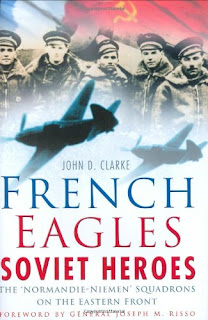This book by John Clarke caught my eye in an Oxfam bookshop. It covers the Free French 'Normandie-Niemen squadrons (escadrilles) on the Eastern Front in WW2.
The French Air Force Groupe was formed on 1 September 1942, using volunteers who had escaped from occupied France or served in North Africa. They arrived in Russia on 28 November and were offered Allied planes, but they chose to fly the new Soviet Yak-1. They started training with these on 19 January 1943, with an initial group of 58 men, primarily pilots and some ground crew supplemented with Soviet Air Force ground crew.
Their initial missions were escorting Pe-2 bombers. The first aerial victories happened in April 1943 when they shot down two Fw-190s. By July, five officers had been awarded Soviet decorations. They fought above the great battle at Kursk when they witnessed the Soviet tactic of ramming enemy aircraft by slicing the tail off with a propellor. This tactic was used 47 times in the Kursk battles alone.
The book covers the many campaigns they took part in. Personally, I find operation air war history a bit repetitive and not a great read. However, it is all here if you want it. The squadrons were upgraded with the latest Yak variants as the war progressed - the Yak-9 had a 37mm cannon, which took some flying skill. In October 1943, the Groupe was awarded the Cross of the Order of the Liberation from General de Gaulle.
By May 1944, the group had grown to four squadrons, flying a mix of Yak-7 and Yak-9 aircraft. The Hitler 'commando order' had been extended to pilots of this Groupe, a testament to their success, but fatal if they crashed behind enemy lines. Only four captured pilots survived. Those who had families back in Vichy, France, were also at risk of being deported to a concentration camp.
The last campaign they fought in was in East Prussia around Koenigsberg. They returned home to a heroes welcome in June 1945 with their planes, which Stalin donated to the new French Air Force.
The Groupe destroyed 273 enemy aircraft, with 37 probable and 45 more damaged. They flew 5,240 combat missions, including 868 aerial combats. Their ground attacks destroyed trains, E-boats, trucks and much else. 42 pilots were killed. There is a plaque to them on the former French Mission building in Moscow, and over 150 Soviet schools were named after them. A single remaining Yak-3 is at the Le Bourget museum.
It is a fascinating story that also covers how the pilots lived and got on with the Soviet pilots. There were easier postings than the Eastern Front, so they deserve to be remembered.
 |
| My Yak fighters for Blood Red Skies |

Interesting. I wasn't aware of this unit before. Intriguing that they opted to fight in the USSR and not out of Britain. Was this political, i.e. were the French crew from the Left?
ReplyDeleteI did wonder that myself but i couldn't see any commentary on that. I suppose that if you were politically right wing you would be more likely to be serving the Vichy regime. All the pilots were volunteers and vetted by the Soviets, although I don't think any were rejected. So, I suspect not unsympathetic if not actual French communist party members. But for others it was probably more pragmatic than political.
DeleteVery interesting. Hopefully this book will give greater public visibility to the exploits of these brave airmen. Sadly this book wouldn’t be one I’d be adding to my library - I’ve got the draw the line somewhere, now that I’m officially a pensioner 😉
ReplyDeleteCheers,
Geoff